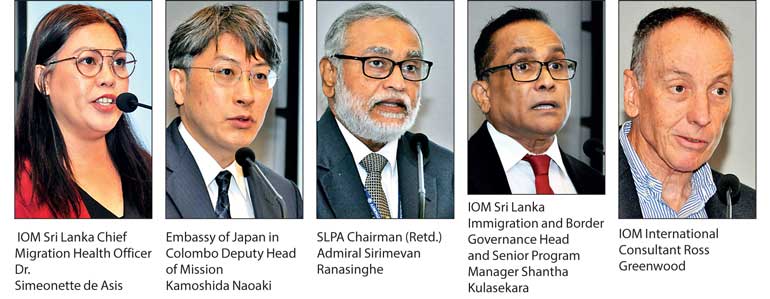Tuesday Dec 16, 2025
Tuesday Dec 16, 2025
Friday, 31 October 2025 00:06 - - {{hitsCtrl.values.hits}}

By Charumini de Silva
Sri Lanka’s key maritime gateways are set for a major overhaul in traveller clearance and public health preparedness following the launch of a new roadmap developed under an $ 8.4 million Japan-funded project by the International Organisation for Migration (IOM) and the Sri Lanka Ports Authority (SLPA).
The Seaport Symposium, held in Colombo yesterday, marked the presentation of the “Baseline Assessment and Roadmap of Traveller Clearance Arrangements at Sri Lanka Seaports,” a collaborative study aimed at improving efficiency, coordination, and health resilience at the country’s ports. The assessment, supported by the Government of Japan, covered the Ports of Colombo, Galle, Trincomalee, and Kankesanthurai, with reference to Hambantota as an emerging maritime hub.
Speaking at the event, IOM Mission in Sri Lanka and the Maldives Chief Migration Health Officer Dr. Simeonette de Asis said the project represents a milestone in Sri Lanka’s efforts to balance border facilitation with health security.
“This collaboration continues to strengthen Sri Lanka’s capacity to manage borders safely and effectively, not only for trade and travel facilitation but also for public health preparedness,” she noted, extending appreciation to the Government and Embassy of Japan for their unwavering partnership.
The project, implemented by the IOM with funding from Japan, aims to ensure that Sri Lanka’s seaports and airports remain operational even during future pandemics or health emergencies, avoiding the economic paralysis seen during COVID-19.
Japanese Embassy in Colombo Deputy Head of Mission Kamoshida Naoaki reaffirmed his Government’s long-term commitment to Sri Lanka’s border infrastructure, recalling Japan’s role in developing the Bandaranaike International Airport (BIA) in the 1980’s, Jaya Container Terminal (JCT) in the 1990’s, and recent projects in Trincomalee and Kankesanthurai.
“The COVID-19 pandemic showed that ports and airports must be capable of protecting the health of staff and travellers, whilst allowing international movement efficiently,” he said.
He explained that infrastructure and equipment alone cannot ensure safety as the right processes and human capacity are essential.
“This symposium is an important opportunity to build that foundation. I hope that the lessons learned will help to ensure a safe and efficient operation or points of entry in this country,” Naoaki added.
Delivering the keynote address, SLPA Chairman Admiral (Retd.) Sirimevan Ranasinghe stressed on the growing importance of Sri Lanka’s ports amid increasing passenger and cargo movement.
“As an island nation on one of the busiest maritime routes in the world, Sri Lanka’s seaports are vital gateways for trade, commerce, and people. Our task is to make these ports more secure, efficient, and health resilient,” he said.
He also noted that the SLPA is upgrading terminal facilities, installing new screening and scanning technologies, and advancing digital transformation through the “Smart Port” initiative.
“Efficient traveller clearances cannot happen in isolation. It requires collaboration among Customs immigration health and port authorities,” Ranasinghe said, pledging the SLPA’s full commitment to implementing the roadmap’s recommendations.
He said the roadmap developed under this assessment offers a clear and practical guideline for the country’s next steps, from procedural harmonisation to infrastructure enhancement and institutional coordination. “We also recognise the importance of sustained investment and joint planning to ensure these improvements are both sustainable and future-ready,” Admiral Ranasinghe said.
The baseline study also highlighted the untapped potential of Sri Lanka’s maritime sector, highlighting that ports currently contribute to around 2-2.5% of GDP, with expectations to reach 6% by 2030.
With nine recognised seaports and five airports serving as official entry and exit points, experts say Sri Lanka’s maritime borders remain underutilised for travel and trade.
IOM Sri Lanka Immigration and Border Governance Head and Senior Program Manager Shantha Kulasekara outlined that the three-year project is valued at $ 8.4 million and encompasses both Sri Lanka and the Maldives.
“The goal is to make our points of entry ‘future ready.’ In the next pandemic, Sri Lanka should not need to close ports or airports entirely. With the right systems and technology, operations can continue safely at minimum capacity,” he added.
Among the major deliverables highlighted by Kulasekara were; the first-ever Automated Border Control (ABC) system at BIA, to be officially launched in December, introduction of biometric access systems and touch-less facilities for airport staff and passengers, donation of 17 large cargo and baggage scanners to enhance Customs and aviation security, construction of Health Office at Colombo Port and provision of advanced health and waste management equipment for ports, development of standard operating procedures for port and airport waste management in collaboration with the International Civil Aviation Organisation (ICAO), and biometric upgrades at 20 Sri Lankan diplomatic missions overseas to support the future rollout of e-passports.
IOM International Consultant Ross Greenwood opined Sri Lanka’s position along vital global shipping lanes provides immense potential to expand maritime trade and tourism. “The report highlights that strengthening traveller clearance ensuring both arrangements is an essential precondition for realising this potential efficiency and security across passenger and crew movements,” he said.
He also asserted that the assessment identifies several opportunities to modernise seaport clearance processes. “The final report includes 46 recommendations, of which 12 are identified as key priorities, covering infrastructure development, data interoperability, and institutional coordination,” he added.
The symposium concluded with a call for sustained inter-agency collaboration and investment to modernise seaport infrastructure, enhance border health systems, and strengthen Sri Lanka’s preparedness for future global challenges, ensuring that the island’s ports remain not just gateways for commerce, but also frontlines of national resilience.
The launch event was attended by senior Government officials, members of the diplomatic community, and representatives from the Ports and Civil Aviation Ministry, Public Security and Parliamentary Affairs Ministry, Health Ministry (Quarantine Unit), Foreign Affairs Ministry, Chief of National Intelligence, President’s Office, Sri Lanka Customs, Department of Immigration and Emigration, Department of Fisheries and Aquatic Resources, SLPA, Embassy of Japan, Key Diplomatic Missions in Sri Lanka, and the IOM.
Pix by Lasantha Kumara